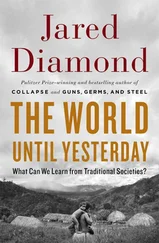Jared Diamond - Guns, Germs & Steel
Здесь есть возможность читать онлайн «Jared Diamond - Guns, Germs & Steel» весь текст электронной книги совершенно бесплатно (целиком полную версию без сокращений). В некоторых случаях можно слушать аудио, скачать через торрент в формате fb2 и присутствует краткое содержание. Жанр: 105. Описание произведения, (предисловие) а так же отзывы посетителей доступны на портале библиотеки ЛибКат.
- Название:Guns, Germs & Steel
- Автор:
- Жанр:
- Год:неизвестен
- ISBN:нет данных
- Рейтинг книги:5 / 5. Голосов: 1
-
Избранное:Добавить в избранное
- Отзывы:
-
Ваша оценка:
- 100
- 1
- 2
- 3
- 4
- 5
Guns, Germs & Steel: краткое содержание, описание и аннотация
Предлагаем к чтению аннотацию, описание, краткое содержание или предисловие (зависит от того, что написал сам автор книги «Guns, Germs & Steel»). Если вы не нашли необходимую информацию о книге — напишите в комментариях, мы постараемся отыскать её.
Guns, Germs & Steel — читать онлайн бесплатно полную книгу (весь текст) целиком
Ниже представлен текст книги, разбитый по страницам. Система сохранения места последней прочитанной страницы, позволяет с удобством читать онлайн бесплатно книгу «Guns, Germs & Steel», без необходимости каждый раз заново искать на чём Вы остановились. Поставьте закладку, и сможете в любой момент перейти на страницу, на которой закончили чтение.
Интервал:
Закладка:
HOW CHINA BECAME CHINESE • 3 2. 3
proceeded to swallow up dozens of non-Slavic peoples, many of which retain their original language and cultural identity. Just as American history is the story of how our continent's expanse became American, Russia's history is the story of how Russia became Russian. India, Indonesia, and Brazil are also recent political creations (or re-creations, in the case of India), home to about 850, 670, and 210 languages, respectively.
The great exception to this rule of the recent melting pot is the world's most populous nation, China. Today, China appears politically, culturally, and linguistically monolithic, at least to laypeople. It was already unified politically in 221 B.C. and has remained so for most of the centuries since then. From the beginnings of literacy in China, it has had only a single writing system, whereas modern Europe uses dozens of modified alphabets. Of China's 1.2 billion people, over 800 million speak Mandarin, the language with by far the largest number of native speakers in the world. Some 300 million others speak seven other languages as similar to Mandarin, and to each other, as Spanish is to Italian. Thus, not only is China not a melting pot, but it seems absurd to ask how China became Chinese. China has been Chinese, almost from the beginnings of its recorded history.
We take this seeming unity of China so much for granted that we forget how astonishing it is. One reason why we should not have expected such unity is genetic. While a coarse racial classification of world peoples lumps all Chinese people as so-called Mongoloids, that category conceals much more variation than the differences between Swedes, Italians, and Irish within Europe. In particular, North and South Chinese are genetically and physically rather different: North Chinese are most similar to Tibetans and Nepalese, while South Chinese are similar to Vietnamese and Filipinos. My North and South Chinese friends can often distinguish each other at a glance by physical appearance: the North Chinese tend to be taller, heavier, paler, with more pointed noses, and with smaller eyes that appear more "slanted" (because of what is termed their epicanthic fold).
North and South China differ in environment and climate as well: the north is drier and colder; the south, wetter and hotter. Genetic differences arising in those differing environments imply a long history of moderate isolation between peoples of North and South China. How did those peoples nevertheless end up with the same or very similar languages and cultures?
China's apparent linguistic near-unity is also puzzling in view of the
3 Z 4 ' GUNS, GERMS, AND STEEL
linguistic disunity of other long-settled parts of the world. For instance, we saw in the last chapter that New Guinea, with less than one-tenth of China's area and with only about 40,000 years of human history, has a thousand languages, including dozens of language groups whose differences are far greater than those among the eight main Chinese languages. Western Europe has evolved or acquired about 40 languages just in the 6,000-8,000 years since the arrival of Indo-European languages, including languages as different as English, Finnish, and Russian. Yet fossils attest to human presence in China for over half a million years. What happened to the tens of thousands of distinct languages that must have arisen in China over that long time span?
These paradoxes hint that China too was once diverse, as all other populous nations still are. China differs only by having been unified much earlier. Its "Sinification" involved the drastic homogenization of a huge region in an ancient melting pot, the repopulation of tropical Southeast Asia, and the exertion of a massive influence on Japan, Korea, and possibly even India. Hence the history of China offers the key to the history of all of East Asia. This chapter will tell the story of how China did become Chinese.
a convenient starting point is a detailed linguistic map of China (see Figure 16.1). A glance at it is an eye-opener to all of us accustomed to thinking of China as monolithic. It turns out that, in addition to China's eight "big" languages—Mandarin and its seven close relatives (often referred to collectively simply as "Chinese"), with between 11 million and 800 million speakers each—China also has over 130 "little" languages, many of them with just a few thousand speakers. All these languages, "big" and "little," fall into four language families, which differ greatly in the compactness of their distributions.
At the one extreme, Mandarin and its relatives, which constitute the Chinese subfamily of the Sino-Tibetan language family, are distributed continuously from North to South China. One could walk through China, from Manchuria in the north to the Gulf of Tonkin in the south, while remaining entirely within land occupied by native speakers of Mandarin and its relatives. The other three families have fragmented distributions, being spoken by "islands" of people surrounded by a "sea" of speakers of Chinese and other language families.
HOW CHINA BECAME CHINESE • 3 2. 5
Especially fragmented is the distribution of the Miao-Yao (alias Hmong-Mien) family, which consists of 6 million speakers divided among about five languages, bearing the colorful names of Red Miao, White Miao (alias Striped Miao), Black Miao, Green Miao (alias Blue Miao), and Yao. Miao-Yao speakers live in dozens of small enclaves, all surrounded by speakers of other language families and scattered over an area of half a million square miles, extending from South China to Thailand. More than 100,000 Miao-speaking refugees from Vietnam have carried this language family to the United States, where they are better known under the alternative name of Hmong.
Another fragmented language group is the Austroasiatic family, whose most widely spoken languages are Vietnamese and Cambodian. The 60 million Austroasiatic speakers are scattered from Vietnam in the east to the Malay Peninsula in the south and to northern India in the west. The fourth and last of China's language families is the Tai-Kadai family (including Thai and Lao), whose 50 million speakers are distributed from South China southward into Peninsular Thailand and west to Myanmar (Figure 16.1).
Naturally, Miao-Yao speakers did not acquire their current fragmented distribution as a result of ancient helicopter flights that dropped them here and there over the Asian landscape. Instead, one might guess that they once had a more nearly continuous distribution, which became fragmented as speakers of other language families expanded or induced Miao-Yao speakers to abandon their tongues. In fact, much of that process of linguistic fragmentation occurred within the past 2,500 years and is well documented historically. The ancestors of modern speakers of Thai, Lao, and Burmese all moved south from South China and adjacent areas to their present locations within historical times, successively inundating the settled descendants of previous migrations. Speakers of Chinese languages were especially vigorous in replacing and linguistically converting other ethnic groups, whom Chinese speakers looked down upon as primitive and inferior. The recorded history of China's Zhou Dynasty, from 1100 to 221 b.c., describes the conquest and absorption of most of China's non-Chinese-speaking population by Chinese-speaking states.
We can use several types of reasoning to try to reconstruct the linguistic map of East Asia as of several thousand years ago. First, we can reverse the historically known linguistic expansions of recent millennia. Second, we can reason that modern areas with just a single language or related
Интервал:
Закладка:
Похожие книги на «Guns, Germs & Steel»
Представляем Вашему вниманию похожие книги на «Guns, Germs & Steel» списком для выбора. Мы отобрали схожую по названию и смыслу литературу в надежде предоставить читателям больше вариантов отыскать новые, интересные, ещё непрочитанные произведения.
Обсуждение, отзывы о книге «Guns, Germs & Steel» и просто собственные мнения читателей. Оставьте ваши комментарии, напишите, что Вы думаете о произведении, его смысле или главных героях. Укажите что конкретно понравилось, а что нет, и почему Вы так считаете.










